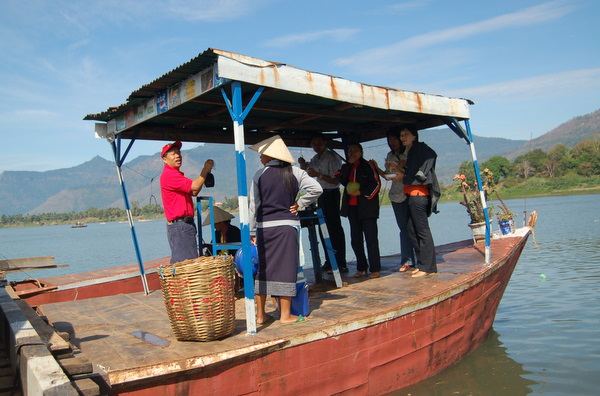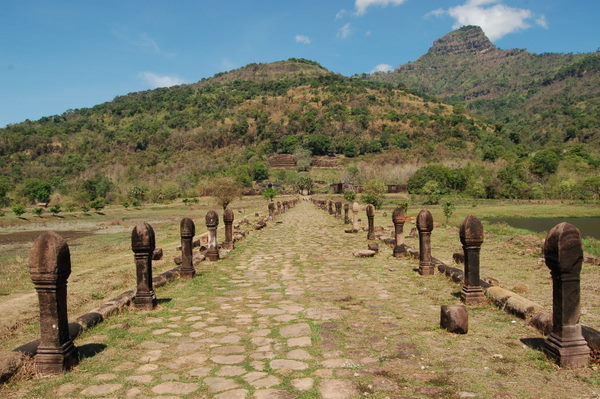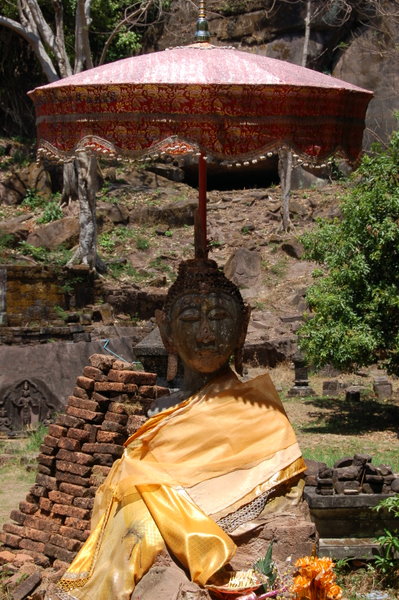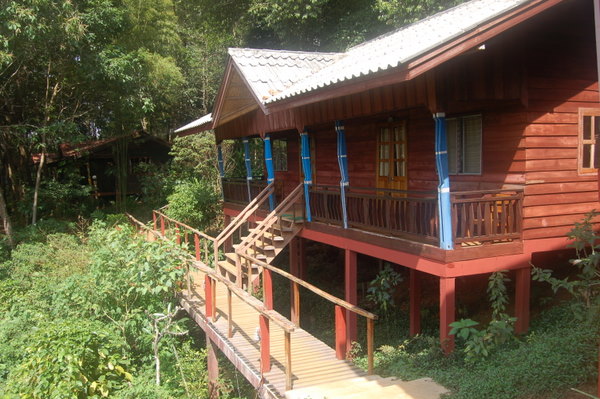Exploring the South in Laos
Table of Contents
- Mekong Expedition 2008
- From China with love
- Keeping my cool in Kuala Lumpur
- Temple-bagging in Thailand
- Crossing the line in Mae Sai
- Disco days in Myanmar
- Through Thailand to the Mekong
- Drinking Beerlao in Laos
- Taking the slow boat
- Riding elephants in Luang Prabang
- Seeking the truth at the Plain of Jars
- Mini-monks in Vientiane
- Exploring the South in Laos
- Swimming in a volcano in Ratakaniri
- Parks and prisons in Phnom Penh
- Gods and demons in Angkor
- Floating away in Vietnam
- Reaching paradise in Phu Quoc
I'm not sure why I thought taking a nine-hour overnight bus down to Pakse was a good idea. The past seven years of travel have taught me that I never sleep on planes or buses. Sure enough I stumbled off the bus at 6am, totally shattered.
I walked down the earth road to the river and on to a big wooden jetty projecting out from the bank, where a few trucks and people in pointy hats were waiting. I spotted one falang with a big rucksack.
"Are you waiting for the boat?"
>"Yes."
(a brief pause)
"Oh, this is the boat."

Crossing the Mekong, pointy hats abound
The wooden jetty I thought I was standing on was in fact strapped on top of three boat hulls. Before long we cast off and headed across the river. The women in pointy hats began mixing up an interesting looking drink, involving milk, ice, and something which looked like pondweed. I decided not to indulge.
On the other side of the river I took an oversized tuktuk to the destination for my day-trip: Wat Phu Champasak. It's Laos' second World Heritage Site and the country's most important archaeological site. An impressive walkway flanked with stone columns led up to a terrace, then I clambered up some extremely steep steps to reach the sanctuary which contained a number of stone Buddhas.

Wat Phu Champasak
The Buddhas smiled serenely: they were rather stylishly clothed in golden robes and one had an umbrella for shade, something which most of the tourists, sweating from the climb in the heat, could have done with.

Happy shaded Buddha
The vehicles that provide public transport across much of the Mekong Region are known as songthaew, a Thai word meaning "two rows" and are basically converted pickups. Two rows of benches are added facing sideways, allowing passengers to sit down, while cargo (or unluckier passengers) go in the middle and on the roof.
The songthaew towards Paksong comfortably seated 8, which is why the driver attempted to cram nineteen paying passengers inside, not to mention several enormous bags of rice, baskets of mangoes and two Frenchmen. Judging we now had a big enough load, our truck finally set off, heaving to get up the small slope out of the bus station and straining to get out of first gear. We'd gone about 2km when we got a flat tyre. Everyone disentangled themselves and got out, waiting under the shade of a tree. We all got in again, cramming in slightly more efficiently on the second attempt. This made the driver confident enough to pick up an additional two passengers who were inserted headfirst between the Frenchmen and the mangoes.
I finally disembarked at the Km 38 marker and set off down the track towards the Tat Fan waterfall.
I was staying at the "Tad Fane" resort, a series of quaint wooden bungalows overlooking the falls. I was the only guest, but due to the noisy chorus of cicadas and the constant crashing of the waterfall, it was anything but quiet! I chatted a bit to "Dolphin", one of the staff, before retiring to bed, passing a giant lizard which was boldly blocking the way back to my bungalow.

My humble bungalow at the Tad Fane resort
The following morning I headed back to the main road and towards Paksong, the main town on the Bolaven Plateau. Dolphin had assured me that the best swimming opportunities were at a waterfall called Tat Yueang, 2km up the road towards Paksong. Being a dolphin, I assumed he knew what he was talking about. Sure enough, I found the turnoff to the falls, and walked down a long, earth-red road to get to the water. There was no-one else around (I'd fallen off the end of the Lonely Planet map) so I plunged straight in. It was good exercise: if you swam in the correct spot you got the effect of an infinite swimming pool: for every stroke you swam forwards, the rushing water would push you back again.
I'd not noticed much French influence. France had governed Laos from 1893 until the Second World War as part of "French Indochina". The Lao people I asked said only old people really spoke French. Back in Pakse, whilst hunting for the post office, I came across a little corner of France. Next to la poste and l'ecole primaire there were several groups of men cheering. On closer inspection they were playing petanque. There were no berets in sight however.
I sat in the shade while other people lost their temper with the driver on my behalf. "I paid 20 dollars for this ticket! They said we get an air-con minibus! This is not a minibus!". I observed that this, indeed, was not a minibus. "This is a Toyota Camry! Look! One-two-three-four-five-six-seven people! We will not fit in the car! We will not get in the car!" I did not get in the car. "We're stranded at this border! How will we cross the border?! This is TYPICAL Lao service!"
Eventually once the arguing had died down, a Mercedes minivan appeared to replace the Toyota and we continued our slow progress into Cambodia. Fifty kilometres later we arrived opposite the town of Stung Treng on the Mekong and got into a low-ceilinged wooden boat to ferry us over, the engine juddering and threatening to jump clear of the vessel at any time.
Read the next entry: Swimming in a volcano in Ratakaniri
